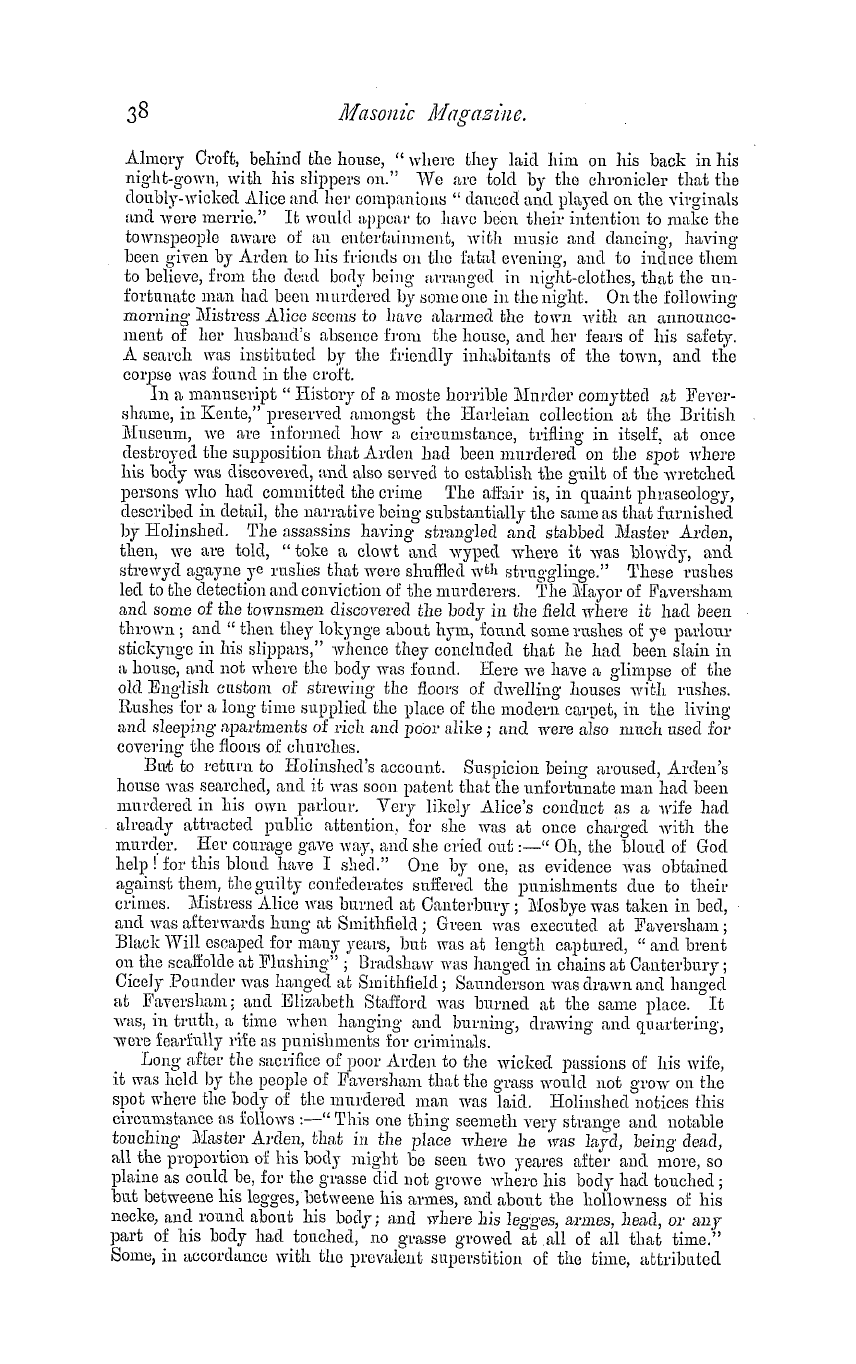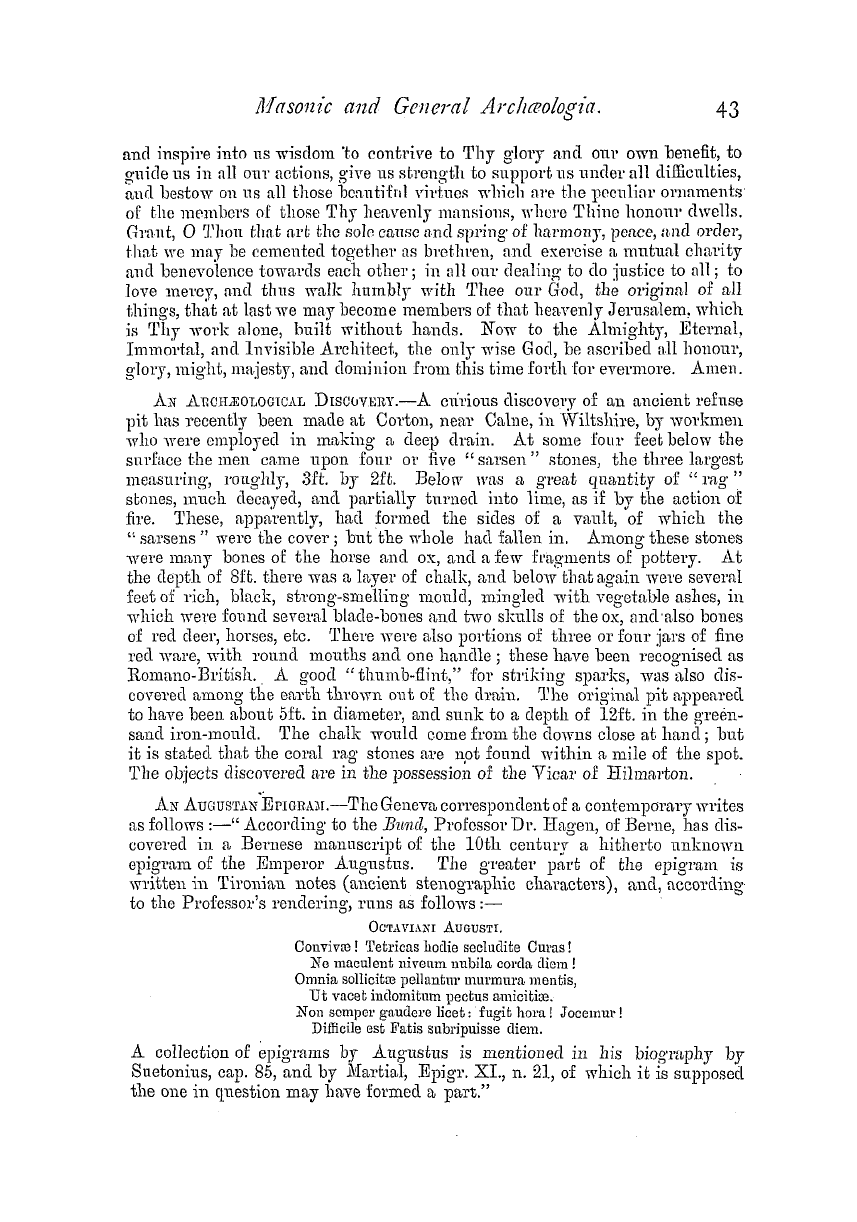Note: This text has been automatically extracted via Optical Character Recognition (OCR) software.
A Sermon
temples . In the interior sanctuary of such temples generally there was the sacred Ark , the nucleus of holiness , containing the highest symbols , winged figures , like those of Cherubim , emblems perhaps of the stability ancl life . In the Hol y of Holies of this Tabernacle were tables of stone on which were graven the great laws of human duty—the revelation of a righteous will requiring righteousness in man . The mercy seat covered the Ark , in testimony
of a mercy that covereth sins . Over this again were the Cherubim , representing the manifold powers of nature , whose over-shadowing wings , meeting in token of harmony , seem to declare that nature also finds its highest glory in subjection to a divine law . The materials also were significant—acacia wood , least liable to decay , representing the imperishableiiess of divine truth , of the laws of duty . All the contents of this sanctuary were overlaid with gold , the
symbol of light ancl purity , the glory of a great King . Yet all this costly material was placed here where no one could see it , because the noblest acts of sacrifice and beneficence are those which are only patent to Him who seeth in secret . The dimensions of this sanctuary were ten cubits every way . There is no doubt that each separate number had its own mysterious significance , and the training of Moses in Egypt must have made him well acquainted with
all these ; so that we need not wonder at the precision of numbers in the plan of the Tabernacle , and the constant recurrence of squares ancl cubes and the numbers four and ten , symbolizing order and perfection . None ever entered into this inner shrine but the hi gh priest , once a year . It was all darkness and solitude : as if to show that li ght ancl life can onl y be attained through darkness and death . Besidesthe symbols of truth miht have otherwise become
, g common and familiar things . Into that darkness once a year , barefooted and in the garb of humiliation , touching with the blood that symbol of life , the mercy seat , came the high priest confessing his own and the people ' s sinsexpressing the truth that men must offer the pure worship of the heart , and
that if such a perfect sacrifice could be found it would work by a mysterious power to cover the multitude of sins . Between this inner sanctuary and the outer was hung the veil , wrought with many colours ancl strange forms . Colours were no less significant than numbers ; ancl the blue , symbol of heaven ; the purple , of kingly glory ; the crimson , of life ancl joy ; and the white , of light and purity , were found there side by side , somewhat after the similitude of a rainbowthe sign of the oldest covenant . In the outer sanctuarysilver
, , , emblematic of human purity , took the place of gold , which typified . Divine glory . This was dail y trodden b y the priests , ancl contained other emblems of Divine realities : the golden lamp with its seven lights , never all extinguished at once , perpetual symbol of all derived gifts of wisdom ancl holiness in man ; the shew bread , serving as a token that Gocl was there read y to accept offerings , though there was no form or likeness of Him ; and the altar of incensewith
, its cloud of fragrant smoke representing the heart ' s adoration , where no strange fire mi ght be kindled . The rest was outside the tent , yet still in consecrated precincts called the court , wdiich was fenced in but open to all the congregation excepting those who were ceremonially unclean . Here was the altar of burnt offerings for all varieties of sacrifice , and the brazen laver for previous purification . Such was the graduated scale of holiness ; first the
outer court , fenced apart from the wilderness around , as the Israelites were from the world ; then the sanctuary , distinguished from it as the sons of Aaron were from the other Israelites - . and the Hol y of Holies , where sanctity culminated , as it did in the person of the Hi gh Priest . The Temple of Solomon was an exact repetition of the wandering tent of meeting , as far as plan and pattern were concerned ; differing onlin being of more durable materials ancl exactl
y y double dimensions . So this also was built and furnished ancl arranged , in every respect according to the pattern showed in the Mount . Its form was copied from the Tabernacle , ancl any architectural ornaments that may have been added were such no doubt as were usual in Palestine , and especially
Note: This text has been automatically extracted via Optical Character Recognition (OCR) software.
A Sermon
temples . In the interior sanctuary of such temples generally there was the sacred Ark , the nucleus of holiness , containing the highest symbols , winged figures , like those of Cherubim , emblems perhaps of the stability ancl life . In the Hol y of Holies of this Tabernacle were tables of stone on which were graven the great laws of human duty—the revelation of a righteous will requiring righteousness in man . The mercy seat covered the Ark , in testimony
of a mercy that covereth sins . Over this again were the Cherubim , representing the manifold powers of nature , whose over-shadowing wings , meeting in token of harmony , seem to declare that nature also finds its highest glory in subjection to a divine law . The materials also were significant—acacia wood , least liable to decay , representing the imperishableiiess of divine truth , of the laws of duty . All the contents of this sanctuary were overlaid with gold , the
symbol of light ancl purity , the glory of a great King . Yet all this costly material was placed here where no one could see it , because the noblest acts of sacrifice and beneficence are those which are only patent to Him who seeth in secret . The dimensions of this sanctuary were ten cubits every way . There is no doubt that each separate number had its own mysterious significance , and the training of Moses in Egypt must have made him well acquainted with
all these ; so that we need not wonder at the precision of numbers in the plan of the Tabernacle , and the constant recurrence of squares ancl cubes and the numbers four and ten , symbolizing order and perfection . None ever entered into this inner shrine but the hi gh priest , once a year . It was all darkness and solitude : as if to show that li ght ancl life can onl y be attained through darkness and death . Besidesthe symbols of truth miht have otherwise become
, g common and familiar things . Into that darkness once a year , barefooted and in the garb of humiliation , touching with the blood that symbol of life , the mercy seat , came the high priest confessing his own and the people ' s sinsexpressing the truth that men must offer the pure worship of the heart , and
that if such a perfect sacrifice could be found it would work by a mysterious power to cover the multitude of sins . Between this inner sanctuary and the outer was hung the veil , wrought with many colours ancl strange forms . Colours were no less significant than numbers ; ancl the blue , symbol of heaven ; the purple , of kingly glory ; the crimson , of life ancl joy ; and the white , of light and purity , were found there side by side , somewhat after the similitude of a rainbowthe sign of the oldest covenant . In the outer sanctuarysilver
, , , emblematic of human purity , took the place of gold , which typified . Divine glory . This was dail y trodden b y the priests , ancl contained other emblems of Divine realities : the golden lamp with its seven lights , never all extinguished at once , perpetual symbol of all derived gifts of wisdom ancl holiness in man ; the shew bread , serving as a token that Gocl was there read y to accept offerings , though there was no form or likeness of Him ; and the altar of incensewith
, its cloud of fragrant smoke representing the heart ' s adoration , where no strange fire mi ght be kindled . The rest was outside the tent , yet still in consecrated precincts called the court , wdiich was fenced in but open to all the congregation excepting those who were ceremonially unclean . Here was the altar of burnt offerings for all varieties of sacrifice , and the brazen laver for previous purification . Such was the graduated scale of holiness ; first the
outer court , fenced apart from the wilderness around , as the Israelites were from the world ; then the sanctuary , distinguished from it as the sons of Aaron were from the other Israelites - . and the Hol y of Holies , where sanctity culminated , as it did in the person of the Hi gh Priest . The Temple of Solomon was an exact repetition of the wandering tent of meeting , as far as plan and pattern were concerned ; differing onlin being of more durable materials ancl exactl
y y double dimensions . So this also was built and furnished ancl arranged , in every respect according to the pattern showed in the Mount . Its form was copied from the Tabernacle , ancl any architectural ornaments that may have been added were such no doubt as were usual in Palestine , and especially
















































